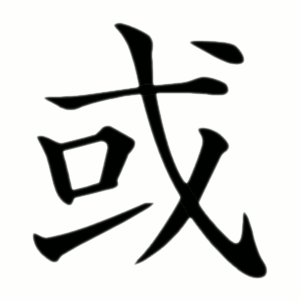或
- perhaps, possibly, or;
- some;
- a certain one;
Etymology
A compound ideograph consisting of:
戈 (창 과) — a halberd, representing military defense or guarding,
口 (입 구) — a mouth, often symbolizing commands or sounds,
一 (한 일) — a boundary line or base mark.
In early forms, these elements combined to depict a warrior holding a spear to defend a walled domain, symbolizing territory or state.
Later, the meaning broadened: guarding against uncertain threats gave rise to the abstract sense of “uncertainty” or “possibility.”
Thus, 或 evolved semantically from “a guarded region” to “a possible or limited part”, “some, perhaps, or.”
Usage in Korean
혹시 (或是) — perhaps; by chance
혹은 (或은 / 或者) — or; alternatively
혹자 (或者) — a certain person; some people
Used both as an adverb (expressing possibility) and a conjunction (offering alternatives).
Its abstract meaning stands in contrast with the concrete territorial sense of its descendant character 國 (country, state).
Words that derived from 或
Additional notes
The philosophical nuance of 或 reflects early Chinese thought on possibility and indeterminacy.
In classical writings, 或 frequently appears in rhetorical or moral discourse to express uncertainty, humility, or alternative cases — paralleling expressions such as “there are those who say…” or “it may be that…”.
In Confucian and Daoist texts, 或 often introduces examples or counterexamples:
或曰 — “Someone said…” or “It is said that…”
signifying openness to multiple perspectives, a hallmark of classical reasoning.
In contrast, its derivative 國 solidified into the concrete notion of territory, while 或 remained abstract, concerned with possibility and speech.
- 戈口一 (IRM)
- ⿹ 戈 ⿱ 口 ㇀
